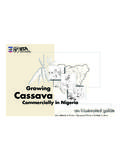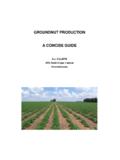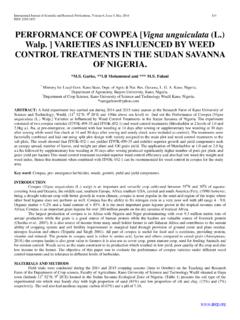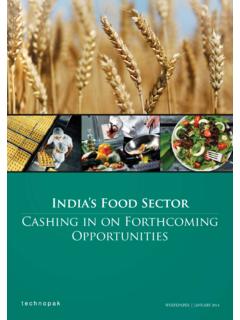Transcription of COMMERCIAL LIVESTOCK PRODUCTION GUIDE …
1 Pig Fattening Technique in NigeriaCOMMERCIAL LIVESTOCK PRODUCTION GUIDE SERIESCOMMERCIAL LIVESTOCK PRODUCTION GUIDE SERIESCOMMERCIAL LIVESTOCK PRODUCTION GUIDE SERIESU nited States Agency for International and Communication Support for Agricultural Growth in CS-Nig eriaRearing Pigs in NigeriaChoice of LandA well-drained land is needed both for housing and paddocking. This will minimize disease outbreak and Large White Large White x Local (Hybrid) Hampshire x Local (Hybrid)HOUSINGThis is determined by the class of the pig. Permanent pig houses should be cool, durable and easy to clean. Floor should be made of concrete, while roofing could, be made of corrugated iron sheets covered with bamboo leaves/grass or adex. The free-range system may be used for the fattening, but the range will need partitioning with fencing materials into paddocks of suitable sizes.
2 Farrowing pen is designed to contain the sow and the piglet. With little restriction and presence of guard rails (open pens) or in a confined space immediately before, and after farrowing. Pregnant or dry sow can 2 Roofing made of corrugated iron sheets covered with bamboo kept in pens designed to accommodate 3 5 animals (3 m x 2 m). An open pen with feeder running from wall or partitioned, so that individual sows have stall and feeding area and a common passage should suffice. The boar pen is of similar design to accommodate a boar and a sow at mating. Fattening pens must be such as to minimize loss of feed resulting from spillage and contamination. A typical fattening pen should be big enough to accommodate 8 12 pigs of the same age and weight. Pens 8 m x 4 m with feeder running from wall to wall, partitioned at 25 cm interval with iron rods to prevent pigs from slipping in the feed procedureA boar should be used sparingly from 1 year of age.
3 He should be able to mate 2 females per week, each mated 2 3 times and should last 2 3 years working life. Pregnant pigs farrow within 2 days before or after 115 days of piglets between 25 and 56 days of dam, never piglets house big and small ones together in the same heaps of grass to prevent tail-bitting, navel sucking or iodine plenty of water and high concentrate house big and small ones together in the same pen. 4 GROWERSRear axes in separate pen between 10 and 12 weeks of growers ration until 30 to fatteners pen from 50 100 kg live to fattener diet:Select good females based on records as replacement for unproductive females among breeding stock. In selecting, the points to look for are: fast growth rate good stand, no deformityva not less than 14 visible prominent nipples on the underline decility unwanted gilts and boars should be fattened out to slaughter as fresh pork (50 70 kg) or baconers (90 - 120 kg).
4 FEEDINGS ucking pig: 24-28% protein needs extra vitamin premix to tide over requires more energy, less protein than sucking piglets, 18 20% be fattened out on similar diet but for greater lean meat deposition, requires a little bit of food restriction or addition of fibrous feeding stuffs in the diet to dilute the energy intake and reduce rate of fat deposition in the carcass. For protein, soybean can replace up to 60% of the protein, while cassava (dried or boiled) can replace much of the energy. Brewers wet grains are cheaper than the dried ones. Where farm is accessible to the wet grains, a slopping concrete floor should be made and the wet grains covered with polyethylene sheets, use up within a diseases include baby piglet anaemia, good management is consult a a good record of your animals performance , number of pigs born, number dead, number of litters raised per sow, number of sows mated per boar per year.
5 Feeds at the different protein levels could be compounded on farm from maize or sorghum, groundnut cake or soybean meal or palm kernel cake, brewers dried grain, rice bran, vitamin-mineral premix, bare meal salt, and palm a good record of your animals performanceCAUTION: MOST DISEASE OUTBREAKS OCCUR DURING THE WEEKEND. BE WARNED. 6 The information for this PRODUCTION GUIDE was obtained with permission from Extension Research Liaison and Training UnitNational Horticultural Research Institute (NIHORT) P M B 5432, Idi - Ishin, Institute of Tropical ICS-NigeriaInformation and Communication Support for Agricultural Growth in Nigeria (ICS-Nigeria) is a project which aims to increase the quantity and quality of information available for increased agricultural PRODUCTION , processing, and marketing and also strengthen the capacity of farmer assistance organizations to package and disseminate information and agricultural technologies to farmers for the alleviation of rural the recent past, investment in the support services to Nigerian agriculture has been neglected with the result that this sector has not realized its full potential to contribute to the prosperity and economic development of the country.
6 Meanwhile, increasing population pressure and the accompanying need to intensify agricultural PRODUCTION is leading to erosion of the natural resource base on which agriculture depends. The sustainability of PRODUCTION is threatened by a vicious cycle of declining soil fertility and increasing problems of pests, diseases, and weeds. Moreover, the lack of knowledge on how to add value through proper storage, processing, and marketing impedes agricultural growth. Promising technologies exist to address these problems, but their adoption is constrained by a lack of information packaged in appropriate formats, and poor communication channels for this information, between farmers and the research, extension, and education organizations that are supposed to address these aims to assist in meeting these challenges by developing appropriate format materials for disseminating information and agricultural technologies to target user groups, while increasing capacity of farmer assistance organizations to produce information materials.
7 At the same time, communication channels will be reinforced so that information fl ow is technologies have been selected on the basis that they will lead to agricultural commercialization thereby enhancing rapid income generation for farmers and private sector practitioners. The project is taking advantage of existing agricultural development programs in Nigeria, national research institutes, and international research institutes in and out of Nigeria to identify these technologies. The project is also taking advantage of existing successful partnerships arising from recent and ongoing programs to enhance information fl ow. ICS-Nigeria is funded by USAID.













